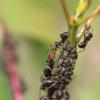1. Location (on a map) of collection: Chile, fifth region, 1000-1200 m asl
2. Date of collection: November 11th
3. Habitat of collection: sclerophyll bush, very close (100 meters) from a stream and sclerophyll forest. Hill, a clear area, packed soil very hard. Around I found some Dorymyrmex sp, and a group of Camponotus morosus. 28 degrees celcius, 1200 m asl, 19:00, 5th region, some kms away from Los Andes city
4. Length (from head to gaster): 10-13mm
5. Color, hue, pattern and texture: as seen in the pics
6. Distinguishing characteristics: nothing that is not seen on the pics
7. Distinguishing behavior: not really
8. Nest description: N/A
9. Nuptial flight time and date: found her still with her wings so the flight had been the same day
[Images of ant]
Here there are many images
https://imgur.com/a/NsoA5
So this is about a queen I found and what I want to know is what genus it is and what gives it away to learn to identify them. If its the subfamily what you can identify its good as well as long as you can give me a "why"
Edited by Skirmitch, December 4 2017 - 9:58 PM.

















